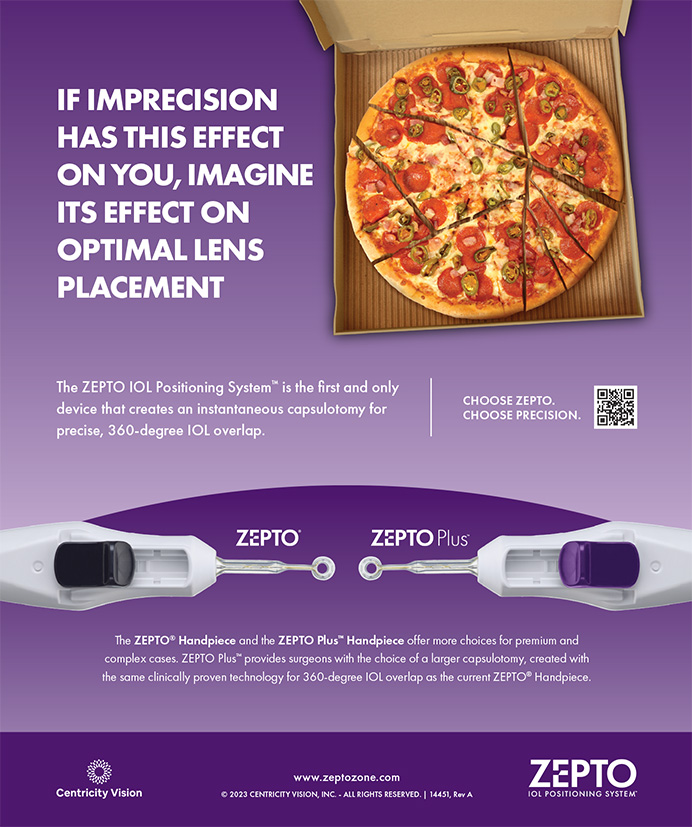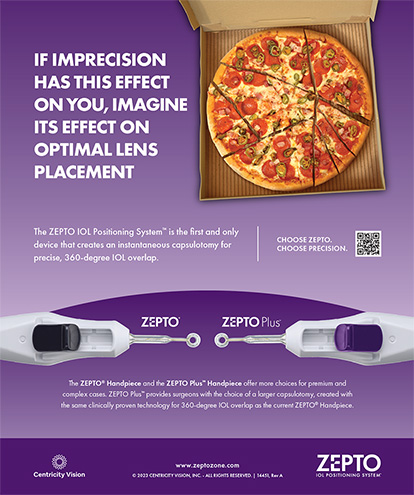A 63-year-old woman presented with visually significant posterior capsular opacification (PCO) in her left eye. She has a
long-standing history of axial myopia in both eyes and dense amblyopia and staphyloma in her right eye
(< 20/800). When the patient underwent cataract surgery in her “good” left eye a few years earlier, her surgeon calculated
an IOL power of zero diopters and therefore decided to leave her aphakic. She has subsequently developed PCO in her
aphakic left eye, reducing her vision to a poor quality of 20/25 with noticeable difficulty driving at night. A consultation
with a retinal specialist confirmed peripheral lattice retinal degeneration without detachment or fluid. How would you
manage the opacified capsule in this highly risk-averse patient, and what are your thoughts about the original decision to
leave her aphakic at the time of cataract surgery?
—Topic prepared by Alan. N. Carlson, MD.
Bala Ambati, MD,PhD
There are a few options in this situation, each with pros and cons. Doing the simplest intervention, an Nd:YAG capsulotomy, opens the door to vitreous prolapse and increases the risk of aphakic glaucoma, cystoid macular edema, and retinal detachment. My recommendation would be to insert a sulcus-fixated three-piece IOL after performing a posterior capsulorhexis with a dispersive viscoelastic (Discovisc [Alcon Laboratories, Inc.] or Healon5 [Abbott Medical Optics Inc.]). A posterior capsulorhexis would be facilitated by a 25-gauge ILM forceps (Grieshaber; Alcon Laboratories, Inc.) or MaxGrip disposable forceps (Alcon Labarotories, Inc.) manipulated by the nondominant hand (to keep the posterior capsule leaflet from falling into the vitreous, where it is hard to grasp) working in tandem with a Utrata or micro- Utrata forceps through the main wound. The posterior capsulorhexis should be small (about 4-5 mm), and posterior optic capture should be performed, followed by evacuation of the viscoelastic and sealing of the wounds. After optic capture, acetylcholine chloride (Miochol-E; Bausch + Lomb) or carbachol solution 0.01% (Miostat; Alcon Laboratories, Inc.) may be used to reduce the risk of the IOL's displacement, but these agents are not necessary. It should be noted that miotic agents may slightly increase the risk of a retinal tear in high myopes.
Preoperatively, I would also obtain a potential acuity meter test and high-definition ocular coherence tomographic scan of the macula to assess the visual potential (the latter to evaluate the external limiting membrane and inner segment/outer segment junction). In fact, if the macula is pristine, a three-piece multifocal lens (available in Tecnis [Abbott Medical Optics Inc.] and Restor [Alcon Laboratories, Inc.] models) could be considered, after a thorough discussion of the risks, advantages, and disadvantages of that technology with the patient. Use of an optic-captured three-piece multifocal IOL might require placement of a three-piece piggyback sulcus-fixated negative-diopter IOL based on power requirements and a limited range of multifocal implants.
With respect to the primary surgery, hindsight is 20/20, yet armchair-quarterbacking never quite captures 360º of the operating room situation. But in general, aphakia is not advisable due to the risk of capsular phimosis, PCO, and aphakic glaucoma. Special-order zero-diopter PCIOLs are available in a three-piece configuration, and they work very well to maintain the capsular bag and visual quality.
Gerd U. Auffarth, MD, PhD, FEBO
I do not sympathize with the surgeon's initial decision to leave the eye aphakic. An IOL even with zero power helps to stabilize the anterior segment and may have a positive impact on delaying PCO. In addition, PCO in an aphakic eye may be more fibrotic, which may lead to higher energy of the Nd:YAG laser. As an alternative to an Nd:YAG laser capsulotomy, the posterior capsule may also be opened by anterior vitrectomy via the paracentesis.
An IOL can still be placed in the sulcus, and it may even be suitable to place the optic through the posterior capsulotomy. If a Soemmering ring cataract is present, a three-piece IOL can be fixated in the sulcus.
Sometimes, it is helpful to initially implant a capsular tension ring in the empty capsular bag to keep the capsular bag open and facilitate implantation of an IOL later on. The chances of a retinal problem such as a retinal detachment are rather small but not zero under the given conditions, however, such complications should always be considered during surgical planning.
David R. Hardten, MD
There are no good controlled studies of aphakia versus zero-powered IOLs, and, therefore, even though my typical decision is to place a zero-powered IOL, I do not feel it is unreasonable to leave the patient aphakic. The IOL power calculations are also variable at that level of myopia, making it difficult to hit the targeted refractive error accurately. If the patient is highly risk averse, then there is no hurry to perform an Nd:YAG capsulotomy, and the patient can decide if he or she is willing to take the small risk of retinal detachment with possible need for repair after the procedure. There is some risk of retinal detachment in this eye even without an Nd:YAG capsulotomy. It would be good to know if the retinal specialists felt that the risk would be less with an Nd:Yag capsulotomy or with a vitrectomy with the removal of the capsule. It appears, however, there was no other current indication for vitreous surgery. If the patient is very concerned about her current level of vision, then I would perform an Nd:YAG capsulotomy with a discussion to return if there are signs and symptoms of retinal detachment. Although it might be overly cautious, I would likely go the extra step of having her see the retinal specialist a few weeks after the capsulotomy.
Douglas D. Koch, MD
I always implant an IOL in axial myopes even if the calculated power is zero; in fact, I did one recently. The IOL may retard PCO, and it certainly will block vitreous prolapse into the anterior chamber when an Nd:YAG laser capsulotomy is needed.
I think that it is important to prevent vitreous prolapse into the anterior chamber. Such a complication can predispose an eye to retinal detachment, even if a posterior vitreous detachment has already occurred, as these eyes often have abnormal vitreoretinal adhesions that persist after a posterior vitreous detachment. Also, vitreous prolapse through a posterior capsulotomy can lead to vitreous stranding and clouding, which can impair the patient's quality of vision.
In this situation, I would attempt to reopen the capsule, polish it, aspirate secondary lenticular material if possible, and insert a zero-diopter IOL in the capsular bag. Fortunately, this maneuver can be done in the majority of eyes, particularly if the capsulotomy was carried out by performing a capsulorhexis rather than using the can-opener approach.
If I am unable to reopen the capsular bag or if zonular support is inadequate, then I would defer IOL insertion unless I could obtain a three-piece design with a large diameter of 14 mm or more. These eyes typically have huge ciliary sulcus diameters, making sulcus fixation of standard IOLs tenuous at best. It would not be unreasonable to suture the IOL to the iris, but there is no guarantee that an IOL in this position would block vitreous prolapse. Hopefully, the capsule could be cleaned sufficiently to at least delay an Nd:YAG capsulotomy.
Alan N. Carlson, MD
Drs. Ambati, Auffarth, Hardten, and Koch bring a comprehensive and critical analysis to this month's case. There is general consensus that the safety and overall biocompatibility of a modern IOL even with zero power positioned within the capsular bag (in comparison with an aphakic eye) would likely (1) delay capsular opacification through contact inhibition, (2) potentially reduce the severity or density of fibrosis that is characteristic of PCO in the aphakic eye, (3) potentially reduce the amount of Nd:YAG laser energy required to open the capsule, and (4) further reduce the risk of vitreous prolapse that is more likely to occur in the absence of an IOL optic and also potentially more effective in the patient with axial myopia and lattice degeneration. This particular patient has dense adherence between her anterior and posterior capsule and is completely lacking the epithelial proliferation that facilitates a surgical separation and opening of the bag with viscoelastic. I respect her risk-averse nature, and presently I am going to observe for any additional loss of vision. When necessary, I will likely use a sulcus-supported PCIOL with preoperative ultrasound biomicroscopy to ascertain sulcus dimension. If I am unable to safely and adequately clear the central capsule at the time of surgery, the IOL optic will lend additional safety for any further treatment needed with the Nd:YAG laser.
Section Editor Alan N. Carlson, MD, is a professor of ophthalmology and chief, corneal and refractive surgery, at Duke Eye Center in Durham, North Carolina. Dr. Carlson may be reached at (919) 684-5769; alan.carlson@ duke.edu.
Section Editor Steven Dewey, MD, is in private practice with Colorado Springs Health Partners in Colorado Springs, Colorado.
Section Editor R. Bruce Wallace III, MD, is the medical director of Wallace Eye Surgery in Alexandria, Louisiana. Dr. Wallace is also a clinical professor of ophthalmology at the Louisiana State University School of Medicine and an assistant clinical professor of ophthalmology at the Tulane School of Medicine, both located in New Orleans.
Bala Ambati, MD, PhD, is a professor of ophthalmology and director of cornea research at the John A. Moran Eye Center of the University of Utah in Salt Lake City. He acknowledged no financial interest in the products or companies he mentioned. Dr. Ambati may be reached at bambati@gmail.com.
Gerd U. Auffarth, MD, PhD, FEBO, is the chairman of the Department of Ophthalmology at the University of Heidelberg in Germany. Professor Auffarth may be reached ga@uni-hd.de.
David R. Hardten, MD, is the director of refractive surgery at Minnesota Eye Consultants in Minneapolis. Dr. Hardten may be reached at (612) 813-3632; drhardten@mneye.com.
Douglas D. Koch, MD, is a professor and the Allen, Mosbacher, and Law chair in ophthalmology at the Cullen Eye Institute of the Baylor College of Medicine in Houston. He acknowledged no financial interest in the product he mentioned. Dr. Koch may be reached at (713) 798-6443; dkoch@bcm.tmc.edu.


